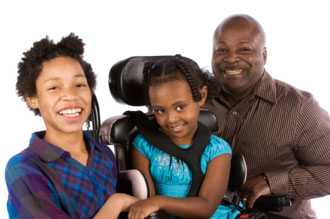Key Findings: Prevalence of cerebral palsy, co-occurring autism spectrum disorders, and motor functioning

The Developmental Medicine and Child Neurology journal has published a new study: “Cerebral Palsy, Co-Occurring Autism Spectrum Disorders, and Motor Functioning – Autism and Developmental Disabilities Monitoring Network, USA, 2008.” Cerebral palsy remains the most common motor disability in childhood, and children with cerebral palsy and their families continue to need support. Communities can use CDC’s information on the number and characteristics of children with cerebral palsy to plan for services, guide policy, and promote full participation in community and family life. Information about the co-occurrence of cerebral palsy and other conditions, such as autism spectrum disorder, can also help direct research into shared risk factors and causes.
You can read the article’s abstract here. See below for a summary of the findings from this article.
What should I do if I think my child might have cerebral palsy?
As a parent, you know your child best. If your child is not meeting the motor or movement milestones for his or her age, talk with your child’s doctor and share your concerns. Do not wait.
To learn more about developmental milestones and get free milestone checklists, please visit CDC’s website: www.cdc.gov/ActEarly
What do new and expecting parents need to know about cerebral palsy?
The majority of cerebral palsy is related to brain damage that happened before or during birth (also known as congenital cerebral palsy). In many cases, the specific cause of cerebral palsy isn’t known.
There are actions people can take before and during pregnancy and after birth that might help reduce the risk of developmental disabilities, including cerebral palsy. For example, taking steps to prevent injuries among infants might prevent some cases of cerebral palsy.
Learn how to…
Main Findings
About 1 in every 323 children in the United States (US) has been identified with cerebral palsy. This estimate comes from the Autism and Developmental Disabilities Monitoring (ADDM) Network, which tracks the number and characteristics of 8-year-old children with autism spectrum disorder and other developmental disabilities in diverse communities throughout the United States. In 2008, there were 14 ADDM Network sites tracking autism spectrum disorder, and four of those sites also tracked cerebral palsy. These four sites, which include areas in Alabama, Georgia, Missouri, and Wisconsin, are referred to as the ADDM CP Network. Based on children who were 8 years old and living in these communities in 2008:
- Cerebral palsy was more common among boys than among girls.
- Cerebral palsy was more common among Black children than White children. Hispanic and White children were about equally likely to have cerebral palsy.
- The majority (77%) of the children identified with cerebral palsy had the spastic (or stiff muscles) type of cerebral palsy.
- Over half (58%) of the children identified with cerebral palsy could walk independently.
- Many of the children with cerebral palsy also had at least one co-occurring condition.
- 41% had co-occurring epilepsy. Co-occurring epilepsy was more common among children with cerebral palsy who had limited or no walking ability.
- Almost 7% had co-occurring autism spectrum disorder. Co-occurring autism spectrum disorder was more common among children with non-spastic cerebral palsy than spastic cerebral palsy.
- It is important to note that the identified prevalence of autism spectrum disorder among children with cerebral palsy was higher than among their peers without cerebral palsy—about 7% vs. 1% 1.
Key Findings Reference
Prevalence of Cerebral Palsy, Co-Occurring Autism Spectrum Disorders, and Motor Functioning – Autism and Developmental Disabilities Monitoring Network, USA, 2008. Christensen D, Van Naarden Braun K, Doernberg N, Maenner M, Durkin M, Arneson C, Benedict R, Wingate M, Fitzgerald R, Kirby RS, Yeargin-Allsopp M. Developmental Medicine and Child Neurology. October 2013.
Additional References
- Centers for Disease Control and Prevention. Prevalence of autism spectrum disorders–Autism and Developmental Disabilities Monitoring Network, 14 sites, United States, 2008. MMWR Surveill Summ. 2012;61(3):1-19.
- Page last reviewed: February 3, 2017
- Page last updated: January 16, 2015
- Content source:


 ShareCompartir
ShareCompartir